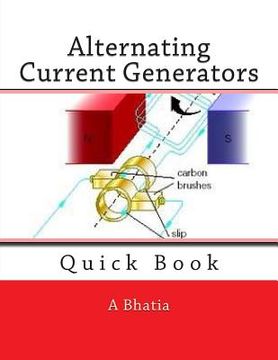Synopsis "Alternating Current Generators: Quick Book (in English)"
An alternating current generator, or AC generator, produces an alternating current, which means the voltage produced alternately reverses from positive to negative polarity, producing a corresponding change in the direction of current flow. Much like a DC generator, an AC generator requires a coil to cut across the force lines of a magnetic field. This coil is attached to two slip rings, which deliver the current to and from the load destination, thus completing the circuit. Alternating current generators are often called "Alternators". The magnitude of AC voltage generated by an AC generator is dependent on (1) The strength of the magnetic field (number of lines of force) (2) The speed at which the loop rotates (3) The number of loops of wire that cut the magnetic field. A rotation speed of 3000 revolutions per minute(RPM) produces 50 Hz, and 3600 RPM produce 60 Hz. The electric current in North American homes has a frequency of 60 hertz while in Europe it is 50 Hz. An alternating current motor, or AC motor uses electrical energy to procude motion and torque. Very simple AC motors are called "Squirrel cage motors"; these have only one or more stationary coils within which a special kind of mechanical rotor is free to rotate. There is no electrical connection to the rotor from the outside. Most AC motors require a starter, or method of limiting the inrush current to a reasonable level. Types of motor starting include reactive (capacitor start and inductive start), and electronic (frequency drives and soft start drives).The reactive start method is usually used on fractional horsepower motors, and the electronic method is usually reserved for larger motors. This 4-hr Quick Book provides a basic understanding of AC motors and generators, explaining how to use them, how to calculate power, and determine torque considerations. The course is based entirely on Naval Education and Training Materials (NAVEDTRA 14177), Electricity and Electronic Training Series; Module-5 and covers Chapter 3 and 4 titled "Alternating Current Generators and Alternating Current Motors". Learning Objective At the conclusion of this course, the reader will be able to: -Describe the principle of magnetic induction as it applies to AC generators. -Describe the differences between the two basic types of AC generators. -Explain the factors that determine the maximum power output of an AC generator. -Describe the relationships between the individual output and resultant vectorial sum voltages in multiphase generators. -List the factors that determine the frequency and voltage of the alternator output. -Describe the purpose and procedure of parallel generator operation. -List three basic types of AC motors and describe the characteristics of each type. -Describe the characteristics of a series motor that enable it to be used as a universal motor. -State the primary application of synchronous motors, and explain the characteristics that make them suitable for that application. -Describe the features that make the AC induction motor the most widely used of electric motors. -Explain the operation of split-phase windings in single-phase AC induction motors. -Describe the effects of shaded poles in single-phase, AC induction motors.

